AM:
I wanted to ask you about how you cast the film. Though the likes
of Elizabeth Hartman, John Carridine, & Peter Strauss were respected
figures at the time, only Dom DeLuise was "the name" star
to filmgoers... I always wondered how you went about finding and casting
the film, as all of their voices were so wonderfully, wonderfully
realized. After all, the direction of an animated film not only pertains
to images and movement, but -- and this point is often overlooked,
even by movie fans -- working with actors and helping them to develop
realistic characters when they face the challenge of not knowing what
their characters and the world around them are like.
DBS:
We really tried to analyze the characters in the film, then relate
each character's personality to an actor or actress or a role that
they had played before. Dom DeLuise was chosen, unanimously, when
Don, Gary and John Pomeroy were all watching the movie THE END on
TV. They tried to call each other on the phone, thinking that Dom
was the perfect voice and could do the personality of Jeremy. Each
of their telephone lines were busy because they were all calling each
other at the same time. Strange!
|
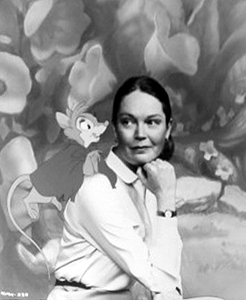 The
voice of Mrs. Brisby was provided by actress Elizabeth Hartman,
who won a Golden Globe and an Academy Award nomination for her
performance in A PATCH OF BLUE (1965) opposite Sidney Poitier
and Shelley Winters. Alas, NIMH was her final film; she died
in 1987. Don Bluth's company published an issue of TOON TALK,
dealing with a NIMH retrospective. In it, Bluth provides a moving
description of his experience in working with Hartman. You can
buy this issue through their website, www.DonBluth.com. The
voice of Mrs. Brisby was provided by actress Elizabeth Hartman,
who won a Golden Globe and an Academy Award nomination for her
performance in A PATCH OF BLUE (1965) opposite Sidney Poitier
and Shelley Winters. Alas, NIMH was her final film; she died
in 1987. Don Bluth's company published an issue of TOON TALK,
dealing with a NIMH retrospective. In it, Bluth provides a moving
description of his experience in working with Hartman. You can
buy this issue through their website, www.DonBluth.com.
|
We
thought of Peter Strauss from his work in the "Rich Man, Poor
Man" mini-series and the telefilm The Jericho Mile. None of the
actors had ever worked on an animated motion picture. Peter was a
method actor and was fairly uneasy about just working with a microphone.
He was used to feeding off other actors, knowing his motivation for
every line was extremely important to him.
Elizabeth
Hartman was very shy and insecure at the first couple of recording
sessions. Don (Bluth) was able to guide her through it. She was very
excited about the script and her role as the mother, Mrs. Brisby.
The
choice for the Great Owl was similar. We all felt that John Carradine
had a great voice and his background was as a Shakespearian actor.
That, and with all the movies he had done, gave us a terrific actor
with great experience in both acting and with life. ...
(He)
arrived at Parmount Studios about an hour late. We rented their recording
facility to record Mr. Carradine's voice. When
he arrived, he appeared to be intoxicated. We called his agent. His
agent told us the Mr. Carradine suffered from acute crippling arthritis
and that he was on pain killers. Since the recording session was in
the afternoon he may have stopped for lunch. And, if he had a Martini,
the combination of the drug and the drink would cause him to appear
pretty much "sloshed". His agent was right.
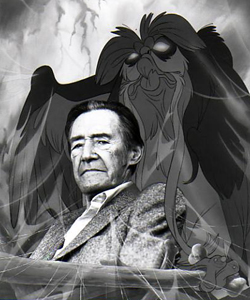 So,
we spent an hour and a half providing him with black coffee and asking
him questions about his old Hollywood experiences. All of a sudden,
he became dead serious and very sober. "Well, we better get on
with this. You're not paying me for an interview." He delivered
every line in one take. If we wanted alternates he would inform us
that we have gotten the best that he had. No retakes, no alternates.
Wow! Good thing he gave a great performance.
So,
we spent an hour and a half providing him with black coffee and asking
him questions about his old Hollywood experiences. All of a sudden,
he became dead serious and very sober. "Well, we better get on
with this. You're not paying me for an interview." He delivered
every line in one take. If we wanted alternates he would inform us
that we have gotten the best that he had. No retakes, no alternates.
Wow! Good thing he gave a great performance.
One
thing of particular interest, John's hands really showed the pain
of his affliction. His knuckles were over-sized and looked gnarled
in the pose he assumed as he read his lines. When he shook your hand,
he could not really clasp your hand properly. He joked,"If you
think my hands are bad, you should see my feet". We all looked
down at his neatly polished dress-shoes, imagining the condition of
his feet and his discomfort in the confinement of the shoes. John
Pomeroy used this fact about Mr. Carradine in the final design of
the Great Owl's feet and the way that the owl walked (with a limp).
We also used a cracking sound effect as the owl rotated his head,
before he spoke to Mrs. Brisby.
Teresa, as you know was one of Shannon Doherty's first roles in film,
long before "Beverly Hills, 90210". Paul Shenar just has
a great villain's voice and, he was very strong at the recording session.
Like Carradine, we got everything in one session. Wil Wheaton was
a regular little professional. He wanted to please and took every
direction from Don, very seriously.
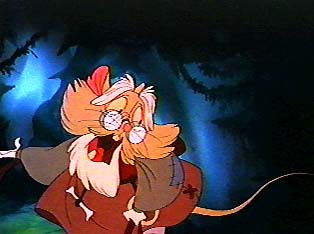 The
crew did some of the crowd voices. We even brought in the Chairman
of UA , Europe, Norbert Aurbach and the then L.A. Times Film Critic,
Charles Champlin, to record two of the the incidental voices in the
film. Naively thinking that we would get more support from studio
marketing by having the Chairman of the company vested in the film.
Also, we secretly hoped that Charles would be given the assignment
to review the film. Whoa, what were we thinking?
The
crew did some of the crowd voices. We even brought in the Chairman
of UA , Europe, Norbert Aurbach and the then L.A. Times Film Critic,
Charles Champlin, to record two of the the incidental voices in the
film. Naively thinking that we would get more support from studio
marketing by having the Chairman of the company vested in the film.
Also, we secretly hoped that Charles would be given the assignment
to review the film. Whoa, what were we thinking?
One of our favorite choices was Mr. Ages' voice, Arthur Malet. He
had been in Mary Poppins and Bedknobs and Broomsticks. We
just thought he was a great character actor. His stammering line-delivery
helped sell the cranky, absent-minded scientist character. It was,
overall, a great experience. All of the actors took a very serious
approach to this film and gave it their all.
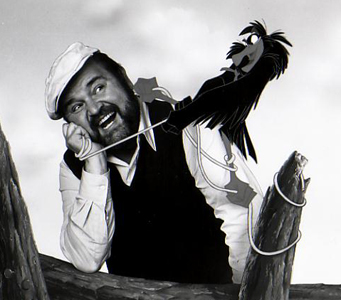 ...
...
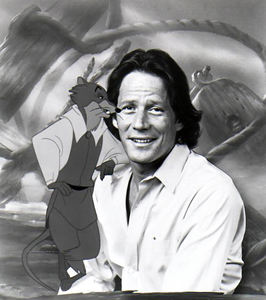
 ...
...
